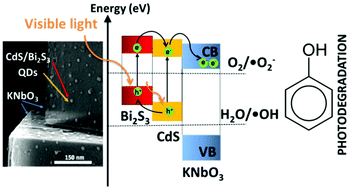Preparation of CdS and Bi2S3 quantum dots co-decorated perovskite-type KNbO3 ternary heterostructure with improved visible light photocatalytic activity and stability for phenol degradation
Abstract
CdS quantum dot-decorated KNbO3 composite photocatalysts co-modified with Bi2S3 QDs were designed and synthesized by a combination of the hydrothermal method with a linker-assisted adsorption route, using starch and thioglycolic acid as capping agents, which facilitated the attachment of modifiers to the surface of potassium niobate. The quantum dots were successfully deposited onto the surface of the perovskite-type KNbO3 with a good dispersion and a stable heterostructure was formed. The as-prepared photocatalysts were subsequently characterized by UV-Vis diffuse reflectance spectroscopy (DRS), X-ray diffraction (XRD), scanning electron microscopy (SEM), scanning transmission electron microscopy (STEM), Fourier transform infrared spectroscopy (FT-IR), Brunauer–Emmett–Teller (BET) specific surface area, X-ray photoelectron spectroscopy (XPS) and photoluminescence (PL) emission spectroscopy. The obtained KNbO3-based composites showed greatly improved photocatalytic performance for the degradation of phenol in the aqueous phase under visible light irradiation (λ > 420 nm) over pristine KNbO3. The highest photocatalytic performance and enhanced stability were observed for the ternary 30% CdS–5%Bi2S3 quantum dot-decorated KNbO3 composite, which could be related to the enhanced visible-light absorption ability, efficient charge separation in the three-level electron transfer heterojunction, improved stability and appropriate amounts of composite components. The formation of a surface layer of CdO decreased the visible light photoactivity of the CdS QD-decorated KNbO3 photocatalysts. The main phenol oxidation intermediates were benzoquinone, catechol, hydroquinone, and 1,2,4-benzenetriol, which underwent further photooxidation to form non-cyclic organic acids. Action spectral analysis proved the better photocatalytic activity of the ternary CdS/B2S3 QDs co-decorated KNbO3 composite compared to the binary CdS QDs decorated KNbO3 sample and revealed that irradiation ranging from 420 to 520 nm was responsible for the visible light photoactivity.



 Please wait while we load your content...
Please wait while we load your content...